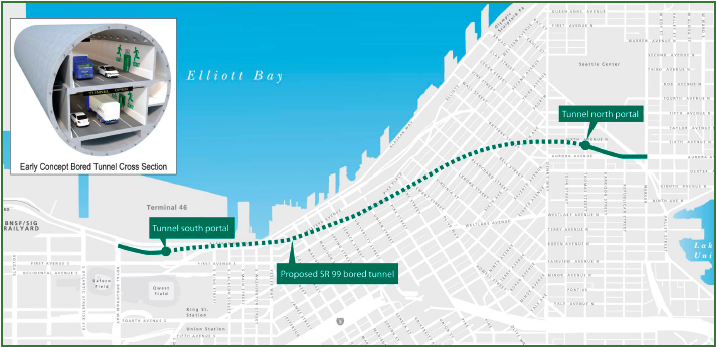EIS supports Alaskan Way tunnel
Jul 2011
Washington State Department of Transportation News Release
- Improved safety, minimized disruption during construction, and fundamental transformation of the city's waterfront are benefits of the bored tunnel preferred option listed in the final environmental impact statement (EIS) for replacement options of the earthquake-damaged elevated highway along the foreshore of Seattle released yesterday (Thursday, 7 July 2011) by the Federal Highway Administration (FHWA), the Washington State Department of Transportation (WSDOT) and the City of Seattle.
-

Bored tunnel preference for viaduct replacement
- Release of the final EIS is the culmination of ten years of technical analysis and public, agency and tribal review and initiates clearance of the last phase of approval before construction of the selected option can begin later this year. Together with the preferred bored tunnel project, the EIS also examines the potential environmental effects of the cut-and-cover tunnel and replacement viaduct alternatives.
- "The final EIS represents countless hours of debate, town hall meetings, public outreach and technical review," said Governor Chris Gregoire.
- "Completing this review process wasn't a sprint, it was a marathon. Now the finish line is in sight, and we’ll begin construction of the bored tunnel this fall."
- The final EIS included information presented in the 2004 draft EIS, the 2006 supplemental draft EIS and the 2010 supplemental draft EIS that took the project through various phases before the bored tunnel was selected as the preferred option in January 2008. In comparing the effects of all three build alternatives, the final EIS explains why a bored tunnel is the preferred alternative.
-
These include:
• Improved safety. The single tube, double-deck, four-lane tunnel creates a new State Route 99 highway with wider lanes, less-abrupt curves, and a construction designed to withstand a 9.0 earthquake. -

Secretary Paula Hammond seals the contract with Fernando González Alcañiz of Dragados
-
• Minimized disruptions. Building the tunnel allows the existing SR 99 viaduct to remain open throughout construction.
• Opportunities to create open public space along the Seattle waterfront once the existing elevated highway is demolished.
• Improved mobility between neighborhoods north and south of the downtown area for bicyclists, pedestrians, freight and other vehicles.
• Upgrade of the waterfront environment by reducing noise, treating stormwater runoff and enhancing views and mobility between city neighborhoods, including the downtown area, Pioneer Square and Belltown. - "This is a long awaited milestone," said Seattle City Council President Richard Conlin. "The final EIS clearly shows that the bored tunnel allows us to keep people and goods moving during construction and makes it possible to transform our waterfront for the people of Seattle and the health of Puget Sound."
- Also discussed in the document are details about applying tolls on the viaduct replacement. Analysis shows that tolling would cause some drivers to shift to downtown streets and other non-tolled routes.
-

Proposed transformation of Seattle's waterfront
- As a result, WSDOT and the City have agreed to establish a Tolling Advisory Committee that will begin this fall to assess and make recommendations to mitigate traffic impacts caused by tolling.
- The final EIS also contains responses to more than 3,000 comments received during the comment periods of the three previous draft documents.
- "We are eager to turn this project into reality," said Washington Transportation Secretary Paula Hammond. "We have already started rebuilding SR 99 at its southern end and have hired a contractor for the tunnel. The sooner we get going, the sooner drivers have safer and more reliable routes into, out of and through downtown Seattle."
- In January 2011, WSDOT signed a design-build contract with Seattle Tunnel Partners, a joint venture between Dragados and Tutor Perini, to advance the bored tunnel's preliminary design. The agency plans to direct the design-build team to begin final design and construction of the bored tunnel in mid- to late August, after the Federal Highway Administration (FHWA) approves the project officially and issues its record of decision.
-
Alaskan Way mega-project procurement - TunnelTalk, Oct 2010
Alaskan Way bored tunnel alignment – video report - TunnelCast, Oct 2010
Alaskan Way contract signed - TunnelTalk, Jan 2011
|
|
|
|
|
Add your comment
- Thank you for taking the time to share your thoughts and comments. You share in the wider tunnelling community, so please keep your comments smart and civil. Don't attack other readers personally, and keep your language professional.
